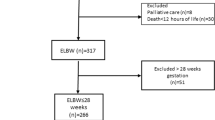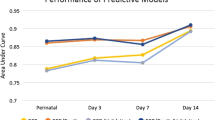Abstract
Objective:
To assess pulmonary outcomes of infants <29 weeks gestational age (GA), delivered at level I, II and III facilities, to identify potentially modifiable factors affecting bronchopulmonary dysplasia (BPD) severity and to assess the external generalizability of the Eunice Kennedy Shriver National Institute of Child Health and Human Development (NICHD) BPD Outcome Estimator.
Study Design:
Outcomes for infants <29 weeks GA born during (2008–2010) and delivered either at an inborn level III center or in a level II or III metropolitan area hospital with transfer to a level IV center, or delivered in a distant level I or II center and then transported to a level IV center were assessed. BPD severity was compared with the NICHD Neonatal BPD Outcome Estimator.
Result:
Of 158 infants who comprised the cohort, 28 (17.8%) had no BPD, 39 (24.2%) had mild BPD, 45 (28.7%) had moderate BPD, 31 (19.7%) had severe BPD and 15 (9.6%) died at ⩽36 weeks post menstrual age. Site of birth did not predict severe BPD or death. Receiver operator characteristic curves showed fair predictability for none/mild and severe BPD.
Conclusion:
BPD severity was not dependent on site of birth. The NICHD BPD outcome estimator provides fair prediction for extreme outcomes.
This is a preview of subscription content, access via your institution
Access options
Subscribe to this journal
Receive 12 print issues and online access
$259.00 per year
only $21.58 per issue
Buy this article
- Purchase on Springer Link
- Instant access to full article PDF
Prices may be subject to local taxes which are calculated during checkout





Similar content being viewed by others
References
Freeman VA . Very Low Birth Weight Babies Delivered at Facilities for High-Risk Neonates: A Review of Title V National Performance Measure 17. University of North Carolina at Chapel Hill, Cecil G. Sheps Center for Health Services Research: Chapel Hill, NC, 2010; 41 pp.
Lemons JA, Bauer C, Oh W, Korones S, Papile LA, Stoll BJ et al. Very low birth weight outcomes of the National Institute of Child Health and Human Development Neonatal Research Network, January 1995 Through December 996. Pediatrics 2001; 107: e1.
Fanaroff AA, Stoll BJ, Wright LL, Carlo WA, Ehrenkranz RA, Stark AR et al. Trends in neonatal morbidity and mortality for very low birthweight infants, NICHD Neonatal Research Network. Am J Obstet Gynecol 2007; 196: 147.
Stoll BJ, Hansen NI, Bell EF, Shankaran S, Laptook AR . Neonatal outcomes of extremely preterm infants from the NICHD Neonatal Research Network, Eunice Kennedy Shriver National Institute of Child Health and Human Development Neonatal Research Network. Pediatrics 2010; 126: 443–456.
Walsh M . Summary proceeding from the BPD Group. Pediatrics 2006; 117: S52–S56.
Finer NN, Carlo WA, Walsh MC, Rich W, Gantz MG, Laptook AR et al. Early CPAP versus surfactant in extremely preterm infants. N Engl J Med 2010; 362: 1970–1979.
Cools F, Henderson D, Offringa M, Askie L . Elective high frequency oscillatory ventilation versus conventional ventilation for acute pulmonary dysfunction in preterm infants. Cochrane Database Syst Rev 2009; (Issue 3)Art. No. CD000104 doi:10.1002/14651858.CD000104.pub3.
Morley CJ, Davis PG, Doyle LW, Brion LP, Hascoet JM, Carlin JB et al. Nasal CPAP or intubation at birth for very preterm infants. N Engl J Med 2008; 358: 700–708 Erratum N Engl J Med. 2008;358:1529.
Laughon MM, Langer JC, Bose CL, Smith PB, Ambalavanan N, Kennedy KA et al. Prediction of bronchopulmonary dysplasia by postnatal age in extremely premature infants, Eunice Kennedy Shriver National Institute of Child Health and Human Development Neonatal Research Network. Am J Respir Crit Care Med 2011; 183: 1715–1722.
Walsh M, Laptook A, Kazzi SN, Engle WA, Yao Q et alNational Institute of Child Health and Human Development Neonatal Research Network. A cluster-randomized trial of benchmarking and multimodal quality improvement to improve rates of survival free of bronchopulmonary dysplasia for infants with birth weights of less than 1250 grams. Pediatrics 2007; 119: 876–890.
Kilbride HW, Gelatt MC, Sabath RJ . Pulmonary function and exercise capacity for ELBW survivors in preadolescence: effect of neonatal chronic lung disease. J Pediatr 2003; 143: 488–493.
Natarajan G, Pappas A, Shankaran S, Kendrick DE, Das A, Higgins RD et al. Outcomes of extremely low birth weight infants with bronchopulmonary dysplasia: impact of the physiologic definition. Early Hum Dev 2012; 88: 509–515.
Ehrenkranz RA, Walsh MC, Vohr BR, Jobe AH, Wright LL, Fanaroff AA et al. National Institutes of Health consensus definition of bronchopulmonary dysplasia. Pediatrics 2005; 116: 1353–1360.
Benaron DA, Benitz W . Maximizing the stability of oxygen delivered by nasal cannula. Arch Peds and Adolesc Med 1994; 148: 294–300.
Warner B, Musial MJ, Chenier T, Donovan E . The effect of birth hospital type on the outcome of very low birth weight infants. Pediatrics 2004; 113 (1 Pt 1): 35–41.
Phibbs CS, Baker LC, Caughey AB, Danielsen B, Schmitt SK, Phibbs RH . Level and volume of neonatal intensive care and mortality in very-low-birth-weight infants. N Engl J Med 2007; 356 (21): 2165–2175.
Lasswell SM, Barfield WD, Rochat RW, Blackmon L . Perinatal regionalization for very low-birth-weight and very preterm infants: a meta-analysis. JAMA 2010; 304: 992–1000.
Lorch SA, Baiocchi M, Ahlberg CE, Small DS . The differential impact of delivery hospital on the outcomes of premature infants. Pediatrics 2012; 130 (2): 270–278.
Murthy K, Zaniletti I, Wadhawan R, Savani R, Lagatta J et al. Predicting death or tracheostomy placement in infants with severe bronchopulmonary dysplasia referred to regional NICUs. PAS 2013 4165.2.
DeMauro S, Karp K, Posencheg M . In-hospital outcomes after implementation of evidence-based guidelines for the delivery room management of very preterm infants. PAS 2013 EPAS 125.
Carlo WA, McDonald SA, Fanaroff AA, Vohr BR, Stoll BJ, Ehrenkranz RA et al. Association of antenatal corticosteroids with mortality and neurodevelopmental outcomes among infants born at 22 to 25 weeks gestatation. JAMA 2011; 306: 2348–2358.
Acknowledgements
This study was supported by the Center for Infant Pulmonary Disorders, Children’s Mercy Hospitals and Clinics. The funding agency provided overall oversight for study conduct. All analyses and interpretation of the data and the preparation, review and approval of this manuscript were independent of the funding agency.
Author information
Authors and Affiliations
Corresponding author
Ethics declarations
Competing interests
The authors declare no conflict of interest.
Additional information
Author Contributions
William E Truog, MD: Involved in study conception, hypotheses delineation and design, data acquisition, data analysis and interpretation, writing and revising the manuscript. Michael F. Nyp, DO: Involved in data acquisition, revising the manuscript. Jane Taylor, MD: Involved in data acquisition, revising the manuscript. Linda L Gratny, MD: Involved in data acquisition, revising the manuscript. Hugo Escobar, MD: Involved in data acquisition, revising the manuscript. Winston M Manimtim, MD: Involved in data acquisition, revising the manuscript. Charisse I Lachica, MD: Involved in data acquisition, revising the manuscript. Ayman Khmour, MD: Involved in data acquisition, revising the manuscript. Okunola O Oluola, MD: Involved in data acquisition, revising the manuscript. Adebayo A Oshodi, MD: Involved in data acquisition, revising the manuscript. Michael Norberg, BS, MDiv: Involved in study design, data acquisition, data design and analysis, writing and revising the manuscript. Hongying Dai, PhD: Involved in statistical analysis. Eugenia K Pallotto, MD, MSCE: Involved in hypotheses delineation, data analysis and interpretation, revising the manuscript.
Rights and permissions
About this article
Cite this article
Truog, W., Nyp, M., Taylor, J. et al. Infants born at <29 weeks: pulmonary outcomes from a hybrid perinatal system. J Perinatol 34, 59–63 (2014). https://doi.org/10.1038/jp.2013.125
Received:
Revised:
Accepted:
Published:
Issue Date:
DOI: https://doi.org/10.1038/jp.2013.125
Keywords
This article is cited by
-
Factors leading to rehospitalization for tracheostomized and ventilator-dependent infants through 2 years of age
Journal of Perinatology (2017)
-
Impact of intercurrent respiratory infections on lung health in infants born <29 weeks with bronchopulmonary dysplasia
Journal of Perinatology (2014)



